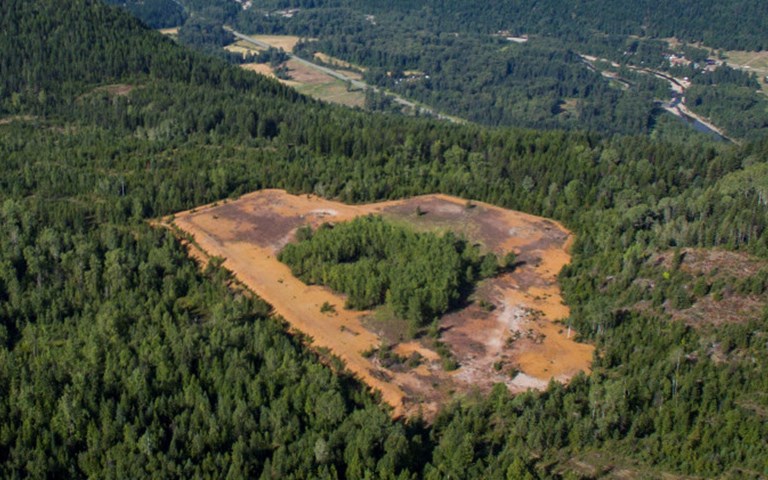An aerial view of the tungsten tailings pile at Jersey-Emerald. Margaux Resources and the Salmo Watershed Streamkeepers Society are working on a plan to recycle the historic tailings. Courtesy of Margaux Resources
A Calgary-based junior mining company and a British Columbia community stewardship group are working together on a plan to recycle and clean up historic tailings at a past-producing mine in south-eastern B.C.
Margaux Resources, which has multiple properties in the region, filed an application to B.C.’s environment and mines ministries in February for a permit to take a 10,000-tonne bulk sample of tailings from the Jersey-Emerald mine. Jersey-Emerald, which was first mined in 1906, produced lead, zinc and tungsten up until 1970.
Before the bulk sample can happen, Margaux not only needs the permit, but must determine the economic feasibility of removing tungsten from the tailings. To that end, Margaux shipped a 3,500 kilogram sample to a Pittsburgh laboratory for testing last September. The company applied for the permit in advance so it can get to work this summer if the tungsten recycling proves economically feasible.
Margaux’s focus in the region includes gold, lead and zinc – and if the tests show good results, the company also plans to extract tungsten from the tailings to produce a mineral concentrate, with the potential for a full-scale tungsten recycling operation at some point in the future.
Related: Tweaking stirred mill spins gold from historical tailings at New Dawn Mining
Margaux is also planning to partner with the Salmo Watershed Streamkeepers Society, a local not-for-profit that focuses on the health of fish and aquatic ecosystems in the watershed. The group has been active for decades on the Salmo River, a tributary of the Columbia River.
“It’s a win for the environment [if] we can take tailings out of the pollution stream,” said Streamkeepers coordinator Gerry Nellestijn. “This could also prove to be a major green economic opportunity.”
Jersey-Emerald is located in the Kootenay Arc, a zinc-lead-silver belt that extends about 300 kilometres across south-eastern B.C. Today there are no active producing mines in the area, but the 150-year mining legacy remains – including at least 40 orphaned mine tailings sites of varying size and pollution footprint. The Streamkeepers have been the driving force behind recent clean-ups of the Yankee Girl and Howard past-producing mines in the belt.
Margaux president and CEO Tyler Rice said it was Ed Lawrence, one of his directors and a past Jersey-Emerald mine manager, who played matchmaker between the company and the Streamkeepers. From the first meeting, he said, the two groups found common ground.
“The major thing that resonated with me, was that profit is no longer being defined by the bottom number on an income statement,” he said. “Those that take from the environment should also consider giving back.”
And from the Streamkeepers’ side, it helped that the group was not blindly opposed to industry. “I talked with Ed and Tyler on many occasions,” says Nellestijn. “I drive a car, I use metal every day, so I’m not opposed to mining. I just think there are better ways of doing it.”
Related: George Salamis explains why he likes investing in old mines, and what comes next for Integra Resources’ new asset
Rice said he was impressed by a process the Streamkeepers developed to expedite the clean-up of legacy mining sites, which could eventually help guide clean-up activities at the tungsten site. Called Rapid Assessment, Rapid Remediation (RAR), it is a process that enables the efficient characterization and assessment of tailings sites – documenting what is there, pin-pointing how to best minimize and eliminate pollution, and how clean-up can be incentivized by extracting valuable components of the tailings. It is an ideal process for a landscape like the Salmo River watershed, where there are many legacy tailings dumps of widely-varying environmental impact.
Tungsten’s big jump in value since early 2017 also makes the legacy tailings an attractive target. “The price of tungsten is relatively high, so it could be economical with very little material processed,” Rice said.
Margaux has recently shipped more tailings samples to South Africa, where smelting tests are being done. Those tests will shed light on the other tailings ingredients, and if the waste generated from the recycling process will be environmentally inert.
Preliminary analysis has found the tailings, in addition to tungsten, contain iron and a lot of silica, which is used in sandblasting. Both could be marketable in the right quantities. “This [analysis] is required to understand how we can deal with some of these ancillary products,” said Rice, “and reduce the [environmental] footprint in putting it back onto the site.”



